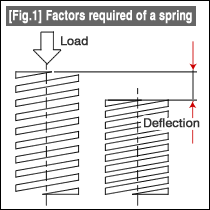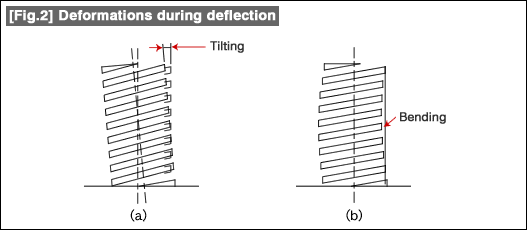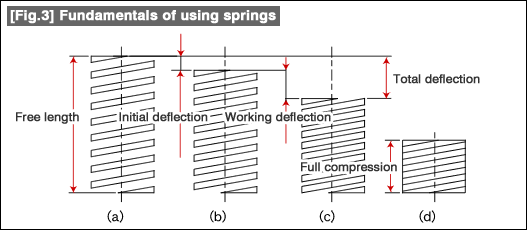#058 Method of Using Standard Components (7) Coil Springs - 1
| What are expected of springs in dies are load and deflection as shown in Fig. 1. For a coil spring (referred to merely as a spring in the following) that supports the lifter spring used in a die, not much load is necessary, but a certain amount of deflection is required. The load is the main requirement in a movable stripper. Sometimes, both load and deflection may be the necessary requirements. |  |
The items required of springs can be many. In order to meet those requirements, springs with various spring constants (in a spring, the force obtained when the deflection is 1mm is called the spring constant) such as springs in which a large deflection is obtained, springs in which extremely strong forces are obtained, and springs in between these. It has become very convenient for die manufacturing. However, load and deflection are inversely proportional to each other, and it can also be said that it is difficult to satisfy requirements of both load and deflection.
Fig. 2 shows the precautions in using springs.

If there is any tilting of the spring as shown in Fig. 2(a), the outer periphery of the spring rubs against the side wall of the hole which reduces the life of the spring. The cause of tilting can be that the processing of the end surface of the spring is bad, or the seating surface of the hole in which the spring is inserted is not good. A spring easily tends to get tilted if placed in a hole that has merely been drilled. Fig. 2(b) shows the phenomenon that occurs in which the spring bends when compressed. This is a problem that can occur easily in springs with large free lengths. Similar to tilting, this also reduces the life of the spring.
Fig. 3 explains the basic method of using springs for compression.

When a prescribed load is required, the amount of deflection is obtained from the relationship with the spring constant, and the spring is compressed from its free length by the amount of this deflection. This amount of deflection is called the "initial deflection" (Fig. 3(b)
The material is pressed using the load obtained from the initial deflection, and the operations of punching or bending are carried out. The spring is further compressed by the punching or bending operation and goes into the state shown in Fig. 3(c). The amount of deflection at this time is called the "working deflection".
The sum of initial deflection and working deflection is the total deflection. The maximum total deflection is the deflection when the spring is in the fully compressed state shown in Fig. 3(d). If the spring is completely compressed, compression force is applied on the spring material itself, and this drastically decreases the spring life. Therefore, normally a spring is not used in this manner. Even though the spring is not fully compressed, the life gets decreased if the amount of deflection exceeds 30% of the free length. Normally, using at a total amount of deflection of 20% of the free length is good for the life of the spring.
- #167 Problems in Punching and their Countermeasures (6) Scrap Processing in Punching
- #166 Problems in Punching and their Countermeasures (5) Trimming of Drawn and Shaped Parts
- #165 Problems in Punching and their Countermeasures (4) Scrap Clogging in Punching
- #164 Problems in Punching and their Countermeasures (3) Bending and Twisting of Narrow Punched Parts
- #163 Problems in Punching and their Countermeasures (2) Bending due to Punching



